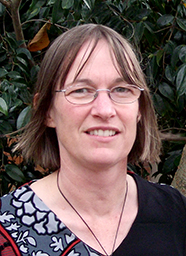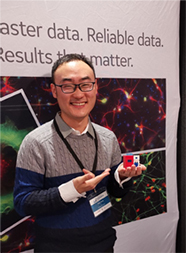Congratulations to Associate Professor Dawn Coates and Dr Zhen Dong, the recipients of our SJWRI Research Publication of the Year awards for this year. Our Research Publication Awards, announced at our Faculty end-of-year function on Friday 17 December, celebrate the best research articles authored by our academic staff and postgraduate students in the preceding year.
Research Publication of the Year: Associate Professor Dawn Coates
This award is to recognise excellence in research by acknowledging the research calibre and effort required to publish in high impact journals in science and dentistry. To be eligible, the manuscript must have been accepted for publication between 1 January and 31 December 2020. The recipient for this year is Associate Professor Dawn Coates.
Porter, G.C., Duncan, W.J., Jude, A., Abdelmoneim, D., Easingwood, R.A., and Coates, D.E. Endocytosed silver nanoparticles degrade in lysosomes to form secondary nanoparticle structures during expression of autophagy genes in osteogenic cells. Nanomedicine: Nanotechnology, Biology, and Medicine, 33:102355. doj: 10.1016/j.nano.2020.102355
The study looks at how silver nanoparticles, which are increasingly used in combination with biomaterials such as bone grafts to provide antimicrobial properties, are taken up by osteogenic (bone-producing) cells, and how the cells are affected by the presence of these nanoparticles. This work was a collaborative effort, led by Associate Professor Coates who oversaw the design of the research program and the supervision of summer student Anne Jude and PhD student Dina Abdelmoneim who conducted some of the experiments. Also involved were Dina's primary supervisor Professor Warwick Duncan, postdoctoral fellow Dr Gemma Cotton and Richard Easingwood of the University's Electron Microscopy Unit.
Nanomedicine: Nanotechnology, Biology, and Medicine is a highly-ranked journal, with an impact factor of 6.458 and is very highly regarded in a number of disciplines with Quartile 1 rankings in the fields of Bioengineering; Biomedical Engineering; Materials Science (miscellaneous); Medicine (miscellaneous); Molecular Medicine; Nanoscience and Nanotechnology; and Pharmaceutical Science.
Abstract
Silver nanoparticles (AgNPs) are increasingly used in combination with biomaterials, such as bone grafts, to provide antimicrobial properties. Our research focused on the cytotoxic and intracellular uptake mechanism of AgNPs on osteogenic cells, and the affected gene expression of osteoblasts exposed to AgNPs. Osteoblast cells were found to be relatively resistant to AgNP exposure, compared to osteoclasts, with a higher IC50 and fewer adverse morphological features. AgNPs were endocytosed within lysosomes, which resulted in the secondary internal formation of curved AgO nano-chains assemblies within the cytosol. Furthermore, osteoblasts demonstrated an oxidative stress response, with autophagic cell death mechanisms, as indicated from qRT2-PCR analysis, with sustained upregulation of the protective gene Heme Oxygenase 1 reaching 86-fold by 48 hours (10 μg/mL). The internalization and fate of AgNPs in osteogenic cells, and the resulting impact on gene expression over time provide further understanding of the nanotoxicity mechanism of AgNPs.
Postgraduate Research Publication of the Year: Dr Zhen Dong
This award is to recognise excellence in postgraduate student research by acknowledging the research calibre and effort required to publish in high impact journals in science and dentistry. The publication must have been accepted between 1 January and 31 December 2020, and have been written by a Masters or Doctoral research student. The recipient is Dr Zhen Dong.
Dong, Z., Li, C. and Coates, D.E. PTN-PTPRZ signalling is involved in deer antler stem cell regulation during tissue regeneration. Journal of Cellular Physiology, 236:3752–3769. doj: 10.1002/jcp.30115
Now a postdoctoral researcher at Westlake University in China, Dr Dong recently completed a PhD in the SJWRI under the lead supervision of A/Prof Dawn Coates, exploring potential biomarkers for mammalian stem cells, as well as the key proteins, biological processes and pathways involved in stem cell maintenance, development and activation during deer antler generation and regeneration. Deer antler is the only known mammalian structure that can annually regenerate to produce a complex tissue, and is therefore unique in providing a mammalian model of complete organ regeneration based on stem cells.
Dr Dong's award-winning publication, 'PTN-PTPRZ signalling is involved in deer antler stem cell regulation during tissue regeneration' gives new and novel insights into the role of pleiotrophin and its receptors in the maintenance of stem cells for regeneration.
The Journal of Cellular Physiology has an impact factor of 6.384, placing it within the 1st quartile of all journals in Clinical Biochemistry and Physiology. Dr Dong conducted all the experiments in the published manuscript, which formed the basis of a chapter of his doctoral thesis. Guidance on experimental design and manuscript editing was provided by his supervisor Associate Professor Coates.
Abstract
A growing deer antler contains a stem cell niche that can drive endochondral bone regeneration at up to 2 cm/day. Pleiotrophin (PTN), as a multifunctional growth factor, is found highly expressed at the messenger RNA level within the active antler stem cell tissues. This study aims to map the expression patterns of PTN protein and its receptors in a growing antler and investigate the effects of PTN on antler stem cells in vitro. Immunohistochemistry was employed to localise PTN/midkine (MDK) and their functional receptors, protein tyrosine phosphatase receptor type Z (PTPRZ), anaplastic lymphoma kinase (ALK), NOTCH2, and integrin αVβ3, on serial slides of the antler growth centre. PTN was found to be the dominantly expressed growth factor in the PTN/MDK family. High expression of PTPRZ and ALK colocalised with PTN was found suggesting a potential interaction. The high levels of PTN and PTPRZ reflected the antler stem cell activation status during the regenerative process. When antler stem cells were cultured in vitro under the normoxic condition, no PTN protein was detected and exogenous PTN did not induce differentiation or proliferation but rather stem cell maintenance. Collectively, the antler stem cell niche appears to upregulate PTN and PTPRZ in vivo, and PTN−PTPRZ signalling may be involved in regulating antler stem cell behaviour during rapid antler regeneration.
Congratulations to Associate Professor Coates and Dr Dong on receiving these awards.
 Associate Professor Coates.
Associate Professor Coates.
 Dr Zhen Dong.
Dr Zhen Dong.